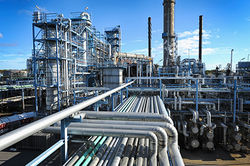Catalytic converters are used in cars to oxidize emission compounds in order to make them less toxic. A similar process may be used in a chemical plant to clean up emissions. A waste gas contains 0.5 mol% C3H8 (propane), 8.5 mol% CO2, 4 mol% O2, 10 mol% H2O and the remainder inert nitrogen (N2). In order to try to remove the propane, it undergoes complete combustion with a catalyst and can be modeled as a reversible reaction. This reaction is undertaken at 1 atm.
Question 3a [5 points]
Is there excess oxygen, if so, what is the % excess of oxygen?
Hint
|
Step 1
After setting up the balanced combustion equation, determine the extent of reaction by setting a basis (i.e 100 moles)
Step 2
Determine the % excess by first calculating the remaining oxygen using the extent of reaction
|
Solution
|
Step 1
The reaction for complete combustion is

Using 100 moles as the basis,
we have 0.5 moles of C3H8 and 4 moles of O2
Since all of propane is combusted, the extent of reaction,  . .
Step 2
Using stoichiometry,

The % excess is then,

|
Question 3b [15 points]
Write out a formula for the equilibrium constant (Ke) in terms of the pressure (P), reaction extent (E) and molar feed (n°C3H8, n°CO2, n°O2, n°H2O, n°N2) of each compound. Simplify the expression algebraically as much as possible. Note that you should not need to perform any calculations for this.
Hint
|
Step 1
Determine the expressions for the equilibrium concentration of each component in the gas
Step 2
Using the expression for equilibrium constant, Ke, rewrite the expression using the expressions determined in step 1
|
Solution
|
Step 1
Find the equilibrium concentration of each component,

Step 2
Since 
![{\displaystyle {\begin{aligned}K_{e}&={\frac {[y_{CO_{2}}\cdot P]^{3}[y_{H_{2}O}\cdot P]^{4}}{[y_{C_{3}H_{8}}\cdot P][y_{O_{2}}\cdot P]^{5}}}\\&={\frac {[n_{CO_{2}}\cdot P/n_{total}]^{3}[n_{H_{2}O}\cdot P/n_{total}]^{4}}{[n_{C_{3}H_{8}}\cdot P/n_{total}][n_{O_{2}}\cdot P/n_{total}]^{5}}}\\&={\frac {[n_{CO_{2}}]^{3}[n_{H_{2}O}]^{4}\cdot P}{[n_{C_{3}H_{8}}][n_{O_{2}}]^{5}\cdot n_{total}}}\\&={\frac {[n_{CO_{2}}^{\circ }+3\xi ]^{3}[n_{H_{2}O}^{\circ }+4\xi ]^{4}\cdot P}{[n_{C_{3}H_{8}}^{\circ }-\xi ][n_{O_{2}}^{\circ }-5\xi ]^{5}[n_{C_{3}H_{8}}^{\circ }+n_{O_{2}}^{\circ }+n_{CO_{2}}^{\circ }+n_{H_{2}O}^{\circ }+n_{N_{2}}^{\circ }+\xi ]}}\\\end{aligned}}}](https://wiki.ubc.ca/api/rest_v1/media/math/render/svg/9f9a99ddfd0dc8861752a00a624fcf3bf9d6fcf1)
|
Question 3c [15 points]
A conversion of 95% of propane from the combustion reaction is achieved. Following this, the remaining propane is removed using an adsorption bed at the same pressure containing 1 tonne activated carbon. Laboratory experiments were undertaken to model the adsorption of propane and gave the results found below, given this how many kilograms of propane can this bed remove?

where 
Hint
|
Step 1
By setting a basis, determine the total number of moles. Subsequently, determine the partial pressure of propane
Step 2
Use the adsorption equation to determine the mass of propane adsorped by activated carbon
|
Solution
|
Step 1
Using 100 moles as the basis again,


Determine the partial pressure of propane,

Step 2

The mass of propane when 1 tonne of activated carbon is used is,

|
Script error: The function "navbox" does not exist.







![{\displaystyle {\begin{aligned}K_{e}&={\frac {[y_{CO_{2}}\cdot P]^{3}[y_{H_{2}O}\cdot P]^{4}}{[y_{C_{3}H_{8}}\cdot P][y_{O_{2}}\cdot P]^{5}}}\\&={\frac {[n_{CO_{2}}\cdot P/n_{total}]^{3}[n_{H_{2}O}\cdot P/n_{total}]^{4}}{[n_{C_{3}H_{8}}\cdot P/n_{total}][n_{O_{2}}\cdot P/n_{total}]^{5}}}\\&={\frac {[n_{CO_{2}}]^{3}[n_{H_{2}O}]^{4}\cdot P}{[n_{C_{3}H_{8}}][n_{O_{2}}]^{5}\cdot n_{total}}}\\&={\frac {[n_{CO_{2}}^{\circ }+3\xi ]^{3}[n_{H_{2}O}^{\circ }+4\xi ]^{4}\cdot P}{[n_{C_{3}H_{8}}^{\circ }-\xi ][n_{O_{2}}^{\circ }-5\xi ]^{5}[n_{C_{3}H_{8}}^{\circ }+n_{O_{2}}^{\circ }+n_{CO_{2}}^{\circ }+n_{H_{2}O}^{\circ }+n_{N_{2}}^{\circ }+\xi ]}}\\\end{aligned}}}](https://wiki.ubc.ca/api/rest_v1/media/math/render/svg/9f9a99ddfd0dc8861752a00a624fcf3bf9d6fcf1)






